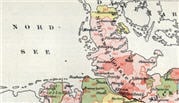Source Information
About Ludwigshafen, Germany, Births, Marriages, and Deaths, 1798-1875
About this collection
This collection contains birth, marriage and death records from Ludwigshafen beginning in 1851 as well as some records beginning in 1798 for formerly independent communities that were later incorporated into Ludwigshafen. Ludwigshafen is situated on the left (west) bank of the Rhine opposite the city of Mannheim. It is located about 12 miles north of Speyer and about 15 miles north-west of Heidelberg in the Rhine-Neckar region in the German state of Rhineland-Palatinate. Ludwigshafen is one of the independent cities in the state of Rhineland-Palatinate which was established in 1946.
Ludwigshafen, named in honor of King Ludwig I of Bavaria, became a municipality in 1852 and was elevated in 1859 to the status of "independent city." Since 1882 it has been officially known as "Ludwigshafen on the Rhine." During the time period of this collection, the communities that now compose Ludwigshafen belonged to the French Republic until 1816 and thereafter to the Kingdom of Bavaria. In addition to Ludwigshafen the collection includes records from another eight communities with records from varying time periods. Some additional documentation on birth, marriage and death records from the 1730s have been added to the original civil registry records for the community of Maudach. Some early civil registry records have also been included for Oggersheim and Rheingönheim.
Beginning on May 1, 1798, birth, marriage and death records in left-bank areas, including the city of Ludwigshafen, followed the model of the French civil registry. Throughout the entire former German Empire, civil registration was taken over and performed by local registry offices beginning in January 1, 1876.
The collected records are arranged chronologically and usually in bound yearbook form which are collectively referred to as "civil registers." Occasionally, alphabetical directories of names were also created. While churches continued to keep traditional records, the State also mandated that the personal or marital status of the entire population be recorded.
What you can find in the records
Civil registrars recorded births, marriages and deaths initially in French and without preprinted forms. After 1815, the forms were often preprinted and filled out in German. In each record the birth date and the death date usually differ from the date they were registered. Depending on the individual form or on the formulations used by the registrar, you may find:
For Births:
- Sequential or Certificate Number
- Registration Date
- Informant: Occupation, Given Names, Last Name, Age, Profession, Residence
- Mother: Given Names, Last Name, Maiden Name, Age, Residence
- Child: Birth Date, Time of Birth, Sex, Given Names
- Signatures
For Marriages:
- Sequential or Certificate Number
- Marriage Date
- Groom: Given names, Last Name, Occupation, Residence, Birthdate and Birthplace, details about his Parents
- Bride: Given names, Last Name, Maiden Name, Occupation, Residence, Birthdate and Birthplace, details about her Parents
- References to, among others, marriage banns
- Witnesses
- Signatures
For Deaths:
- Sequential or Certificate Number
- Registration Date
- Informant: Given Names, Last Name, Occupation
- Deceased: Given Names, Last Name, Maiden Name, Occupation, Age, Residence, Birthplace, Spouse/Parents, Place/Date of Death, Time of Death
- Signatures
More about using this collection
Depending on the year and type of register, pages may contain multiple entries (written one after the other). An entry may start on one page and continue on to the next.
Civil Registry records may have had additional events from the life of the person recorded later on in the margins. These notes, sometimes referred to as "narration," can contain very useful information but they have not been indexed. As a result, information from the notes will not found via the search form.
The French Republican Calendar was used in the registers (until December 31, 1805).
Under "Browse this collection,” select the Civil Registration Office and the Event Type (Geburt = Birth, Ehe = Marriage and Sterbe = Death).Then select the Year Range and Volume for the register desired.
 Need help with the German language? Find resources in our German Research Center.
Need help with the German language? Find resources in our German Research Center.